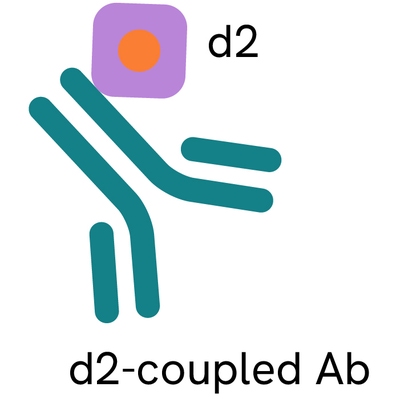

HTRF Anti-VHH d2-Antibody, 5,000 Assay Points

HTRF Anti-VHH d2-Antibody, 5,000 Assay Points


| Feature | Specification |
|---|---|
| Application | Protein-Protein Interaction |



Product information
Overview
Monoclonal anti-VHH antibody has been labeled with d2 and binds to the native form of both alpaca and llama VHH, as well as recombinant nanobodies. The binding is rapid and stable, making it an ideal choice for use in a variety of assays including nanobody selection and titration.
How it works
Assay principle
In an HTRF interaction assay, one partner is labeled (directly or indirectly) with the donor, and the other with the acceptor (again, directly or indirectly). The intensity of the resulting signal is proportional to the binding of the 2 partners. In the example shown here, anti-VHH-d2 binds to the nanobodies raised against protein A, while partner A* binds to a specific Ab labeled with an HTRF donor.
*partner A can also be biotinylated, tagged, or Fc fused. In these cases, use the corresponding HTRF reagent (anti-Tag, anti-species, protA, Streptavidin) labeled with a donor for the detection.

Assay protocol
The example on the right describes the protocol using a 20 µL final assay volume for the detection of an interaction between a nanobody raised against protein A and a non-tagged partner A*. Dispense the two partners (10 µL): i.e. protein A+nanobody, add anti-partner A labeled with donor (5 µL), and anti-VHH-d2 (5 µL) Then incubate, and finally read.
*partner A can also be biotinylated, tagged or Fc fused. In these cases, use the corresponding HTRF reagent (anti-Tag, anti-species, protA, Streptavidin), labeled with a donor for the detection.

Specifications
| Application |
Protein-Protein Interaction
|
|---|---|
| Brand |
HTRF
|
| Detection Modality |
HTRF
|
| Product Group |
Fluorescent Reagent
|
| Shipping Conditions |
Shipped Ambient
|
| Target Class |
Binding Assay
|
| Technology |
TR-FRET
|
| Unit Size |
5,000 assay points
|
Resources
Are you looking for resources, click on the resource type to explore further.
Proteins and their interactions have a history of keen research and technological innovations. All scientists deciphering the...
Discover the versatility and precision of Homogeneous Time-Resolved Fluorescence (HTRF) technology. Our HTRF portfolio offers a...
Protein-protein interactions are like sandwiches: there’s no end in sight and no one knows what yours need better than you do.
With...
SDS, COAs, manuals and more
Are you looking for technical documents related to the product? We have categorized them in dedicated sections below. Explore now or request your COA/TDS, SDS, or IFU/manual.
- LanguageEnglishCountryUnited States
- LanguageFrenchCountryFrance
- LanguageGermanCountryGermany
- Lot Number01ALot DateNovember 15, 2026
- Resource TypeManualLanguageEnglishCountry-


How can we help you?
We are here to answer your questions.






























